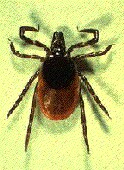
WEDNESDAY, July 6 (HealthDay News) — Move over, Lyme disease: Another tick-borne illness is on the rise in various parts of the country, and this one can kill.
Known as babesiosis, the disease is caused by a microscopic parasite that attacks blood cells, causing flu-like symptoms that can make it difficult to accurately diagnose. Like Lyme disease, which is caused by bacteria, babesia microti parasites are carried by deer ticks.
First documented in Massachusetts in 1969, the once-obscure babesiosis has surfaced as a significant public health threat in parts of the Northeast and Upper Midwest over the last several years. A recent study in the journal Emerging Infectious Diseases, published by the U.S. Centers for Disease Control and Prevention, revealed that between 2001 and 2008 cases climbed from six to 119 in New York’s Lower Hudson Valley — a 20-fold regional increase.
And many cases may be escaping detection, experts say.
“I think it’s underreported. One of the reasons we’re seeing more about it is because people are becoming more aware,” said Dr. Peter Krause, a babesiosis researcher and senior research scientist at the Yale University School of Public Health. “The theory is that it’s spreading from east to west, as if you were dropping a pebble in a pond and it spread outward geographically.”
About 1,000 cases are reported annually in affected locales, Krause said, but many people with babesiosis have no symptoms and never know they’re harboring the parasite. For others, symptoms can include high fever, severe headache, fatigue, chills, and muscle aches and pains. It is treated with antimicrobial drugs, such as antibiotics.
People with compromised immune systems — including the elderly and those with cancer, HIV or no spleens — are especially at risk of potentially deadly complications such as organ failure. Between 10 percent and 20 percent of patients in those populations die as a result, Krause said.
The more prolific Lyme disease causes similar symptoms in early stage cases but is easier to diagnose by its telltale bullseye rash, said Dr. Barbara Herwaldt, a medical epidemiologist at the CDC who specializes in parasitic conditions.
Deer are pivotal to the life cycle of ticks carrying the babesia microti parasite by serving as a blood meal, shelter and a place to mate, Krause said. Ticks also feed on birds, who serve as carriers for Lyme disease, which affects the entire continental United States. Fortunately for humans, birds don’t carry babesia microti.
Krause noted that ticks need a moist climate to thrive, so dry states such as Arizona are not likely to see babesiosis cases caused by tick bites. But the disease can potentially spread to all states in an even sneakier way — through the blood supply.
Although a blood screening test is in trials, Krause said, donors are currently only asked if they have had babesiosis, and those who harbored it but never showed symptoms can pass it through their donated blood. And because most blood recipients are already physically compromised, babesiosis has about a 30 percent mortality rate in that group, he said.
“Getting babesiosis through the blood supply is a rare event and people shouldn’t panic,” he said. “I don’t think it will reach a crisis level, but it’s still a concern.”
To help prevent babesiosis, the CDC advises people with compromised immune systems or other vulnerabilities to avoid tick-infested wooded areas, particularly during warm months. The agency also recommends that everyone walk in the middle of trails and avoid bushy areas with lots of leaves or tall grasses and to use the repellent DEET and pre-treat clothes with an insect repellent containing permethrin before going outdoors.
The CDC also recommends doing full-body checks and showering within a few hours of being in the woods, as well as tossing used clothes in the dryer to kill any ticks that might be hiding there.
The authors of the study also advised clinicians to consider babesiosis in patients who have been exposed to ticks or received blood products and who show up for treatment with a fever and anemia resulting from the destruction of red blood cells.
More information
Learn more about babesiosis at this CDC website.

